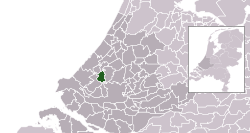Delft Explosion
| Delft | |||
|---|---|---|---|
| City and Municipality | |||

Aerial view of Delft with from left to right three churches, a university tower building and a windmill.
|
|||
|
|||
 Location in South Holland |
|||
| Coordinates: 52°0′42.25″N 4°21′33.15″E / 52.0117361°N 4.3592083°ECoordinates: 52°0′42.25″N 4°21′33.15″E / 52.0117361°N 4.3592083°E | |||
| Country | Netherlands | ||
| Province | South Holland | ||
| Government | |||
| • Body | Municipal council | ||
| • Mayor | Marja van Bijsterveldt (CDA) | ||
| Area | |||
| • Total | 24.06 km2 (9.29 sq mi) | ||
| • Land | 22.82 km2 (8.81 sq mi) | ||
| • Water | 1.24 km2 (0.48 sq mi) | ||
| Elevation | 0 m (0 ft) | ||
| Population (February 2017) | |||
| • Total | 99,737 | ||
| • Density | 4,371/km2 (11,320/sq mi) | ||
| Demonym(s) | Delftenaar | ||
| Time zone | CET (UTC+1) | ||
| • Summer (DST) | CEST (UTC+2) | ||
| Postcode | 2600–2629 | ||
| Area code | 015 | ||
| Website | www |
||
Delft ([dɛlft]) is a city and a municipality in the Netherlands. It is located in the province of South Holland, to the north of Rotterdam and south of The Hague.
Delft is known for its historic town centre with canals, Delft Blue pottery, the Delft University of Technology, jurist Hugo Grotius, painter Johannes Vermeer and scientist Antony van Leeuwenhoek, and its association with the royal House of Orange-Nassau.
The city of Delft came into being aside a canal, the 'Delf', which comes from the word delven, meaning delving or digging, and led to the name Delft. It presumably started around the 11th century as a landlord court.
From a rural village in the early Middle Ages, Delft developed to a city, that in the 13th century (1246) received its charter. (For some more information about the early development, see Gracht).
The town's association with the House of Orange started when William of Orange (Willem van Oranje), nicknamed William the Silent (Willem de Zwijger), took up residence in 1572. At the time he was the leader of growing national Dutch resistance against Spanish occupation, known as the Eighty Years' War. By then Delft was one of the leading cities of Holland and it was equipped with the necessary city walls to serve as a headquarters. An attack by Spanish forces in October of that year was repelled.
...
Wikipedia


